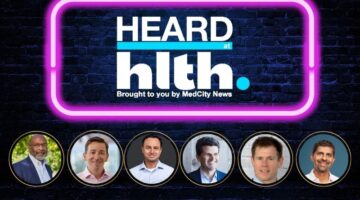Every year I write about the projects and trends which keep me up at night. Here’s my list for FY12:
1. Workforce recruitment/retention – $27 billion in stimulus funds from HITECH have increased demand for experienced IT staff to implement and support electronic health records. In many ways, it’s a mini “dot com” boom for healthcare IT experts. This makes recruiting and retaining qualified staff even harder. Tomorrow, I’m meeting with a consulting team to formulate an FY12 workforce strategy.
2. 5010/ICD10 – 5010 describes a set of X12 standards used for administrative transactions (benefits/authorization. referral authorization, claims). Payers and providers must support 5010 by January 1, 2012 or risk disruption of the revenue cycle. BIDMC completed all its 5010 work and is now in final testing with every payer. Most payer and provider stakeholders will meet the deadline, but significant resources have been pulled from other projects. ICD-10 implementation is required by October 1, 2013 and I’ve written about those challenges. Billions will be spent, many healthcare IT projects will be deferred for the next 2 years, and the end result will be no cost savings (coding costs are likely to increase 50%), no quality improvement, no increased safety, and no efficiency gains. If we complete the ICD-10 project on time, no one will notice, but customers will all be angry at the IT department (and the CIO) for the work on other projects that was deferred.
3. Vendor Product Quality – over the past year, I’ve had several bad experiences with infrastructure and application vendors which delivered products that did not have the reliability, security, or performance promised. Why?
* the pace of innovation is so fast, that time for quality assurance is diminished.
* the economy has stressed companies and they are focused on making as many sales as fast as they can while controlling development and support costs
* the end result is less satisfied customers.
4. Storage growth – BIDMC is approaching 2 petabytes of clinical data and Harvard Medical School has exceeded 3 petabytes of research data. Balancing transactional performance, reliability, and the cost of storage at petabyte scale is very challenging. In FY12, I’ll continue to introduce new storage technologies and management tools (including chargebacks to sustain the cost of storage growth), with the hope that I’ll be able to keep up with demand.
5. Analytics/Business Intelligence – We have petabytes of data but users want information, knowledge and wisdom. In FY12, I have a five part strategy to support analytics:
a. For comprehensive ad hoc analytics with quality assurance, BIDMC has an expert data mining team which can explore any clinical or financial data while reviewing the accuracy of the underlying data.

Heard at HLTH 2024: Insights from Innovative Healthcare Executives
Executives from Imagine360, Verily, BrightInsight, Lantern, and Rhapsody shared their approaches to reducing healthcare costs and facilitating digital transformation.
b. For less rigorous ad hoc analytics, we have a self service query tool which enables users to explore data themselves. However, such self service queries are unlikely to filter out data of questionable quality (men having babies, women having prostate procedures etc)
c. For reports that are run frequently, we’re developing a new set of business intelligence tools that use Microsoft SQL Analysis and Reporting services.
d. For our Blue Cross Alternative Quality Contract and our Accountable Care organization activities we have a Quality Data Center that aggregates clinical data. We also have an all payer claims data warehouse.
e. For unstructured data we plan to experiment with a new generation of natural language processing tools
6. Healthcare Reform and Mergers – Accountable care organizations require substantial IT investments and new processes to coordinate/manage care across the community. Smaller organizations may be unable to implement all that is needed so they may seek mergers with a larger organization. Today I oversee the IT requirements for 2 hospitals and multiple clinician groups. Over the next year, I believe the number of affiliated organizations requiring IT support will increase, requiring new investments in healthcare information exchange and analytics.
7. Mobile devices/consumer IT – We have 1000+ iPads accessing our web-based applications today. Clinicians are mobile people and need to view results, enter orders, and communicate with team members at the bedside. Increasingly they’ll want to use their own devices, which creates support and security challenges.
8. Governance – Governance is essential to maintain satisfaction in budget constrained times. In all IT organizations, the supply of resources is fixed, but demand is infinite. There’s an direct relationship among project scope, project timing, and project resources. Governance and communication are the best tools to reduce scope, limit demand, and keep satisfaction at reasonable levels. Here’s how BIDMC does it.
9. Compliance/Regulatory Pressures – At the same time that Meaningful Use empowers care coordination, population health, and public health with health information exchange, the penalties for privacy breaches have increased. Thousands of new regulations have been enacted in the US during my 15 years as CIO. With nearly 25% of my IT organization working on some aspect of compliance, the amount of time left for innovation is diminishing.
10. Security – The internet has become a swamp with nearly 50% of internet devices infected with some type of malware. The most basic freedoms we’ve enjoyed on the internet – the ability to visit any site, experiment with new applications, and share media with friends, is now a threat to the privacy of business data. The next year will require us to rethink how consumer computing and business computing can co-exist.
That’s an intimidating list. However, there is always hope and we’ll make progress in all these areas over the next year. By FY15, we will not even remember the events of FY12. Accelerating challenges come with the territory of being an IT leader. Keep smiling.
The author, Dr. John D. Halamka, is chief information officer and dean for technology at Harvard Medical School who writes at Life as a Healthcare CIO.
Dr. John D. Halamka is chief information officer and dean for technology at Harvard Medical School who writes at Life as a Healthcare CIO.
This post appears through the MedCity Influencers program. Anyone can publish their perspective on business and innovation in healthcare on MedCity News through MedCity Influencers. Click here to find out how.










